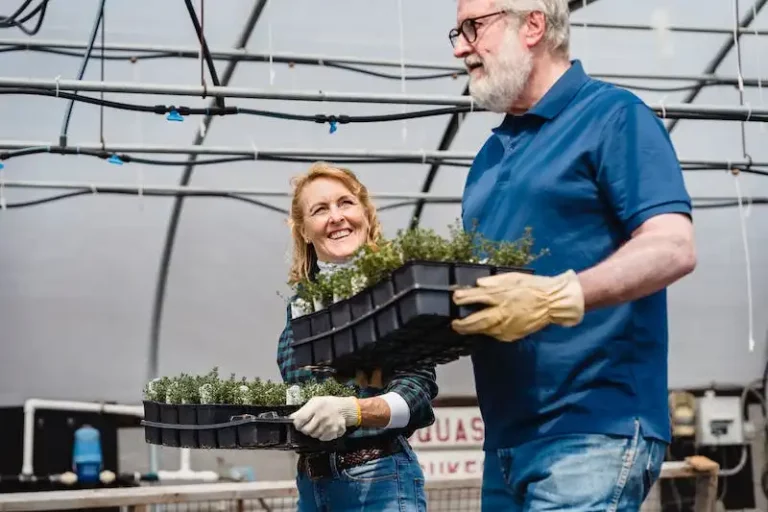Gardeners who love having fresh herbs in their kitchen should consider growing savory. This versatile herb is easy to grow, and it adds a savory seasoning to many dishes. Savory is a member of the mint family and comes in two main types: summer savory and winter savory.
If you plan on growing savory, choose a well-drained and sunny spot in your garden. Savory can tolerate a wide range of soil types, but it prefers a pH between 6.0 and 7.0. It’s also important to note that savory is not frost-tolerant, so gardeners in cooler zones should wait until mid-May to plant it outdoors.
Although savory can be grown from seed, many gardeners prefer starting with nursery-grown plants. This ensures a more reliable and faster growth. Plant the savory seedlings about 12 inches apart in the garden, and give them frequent watering to promote strong root development. Savory plants should be watered regularly to keep the soil consistently moist.
Once the savory plants have established, they don’t require much care. They are hardy and can tolerate both high temperatures and high humidity. Savory is a low-maintenance herb that can be grown in containers as well, making it accessible for those with limited garden space.
When it comes to harvesting savory, it’s best to do so during the early morning hours when the essential oils are at their highest concentration. Cut the stems close to the base of the plant, and make sure to prune only one-third of the plant at a time. This will allow the plant to continue growing and producing new foliage.
Once harvested, drying the savory is an excellent way to preserve its flavor for future use. Hang the harvested branches upside down in a warm, dark, and well-ventilated area. The temperature should be between 70 and 80 degrees Fahrenheit with low humidity. After a few weeks, the savory leaves should crumble easily when touched.
In conclusion, growing and drying savory is a rewarding experience for any herb enthusiast. With its bright flavor and versatile culinary uses, this herb is a valuable addition to any kitchen. With proper care, you can enjoy the savory seasoning all year round, even during the winter months when fresh herbs are scarce.
Purple winter savory savory in any season
If you want to grow savory in your kitchen all year long, even in winter, the purple winter savory is a great choice. This herb can be grown both indoors and outdoors and is known for its strong flavor and high hardiness.
In the kitchen, purple winter savory can be used to add a distinct flavor to various dishes. Whether you are cooking meat, fish, or vegetables, this herb will enhance the taste of your food. Its flavor is described as a mix of thyme and marjoram with a hint of lemon.
To start growing purple winter savory, you can either buy seedlings or sow the seeds directly in your garden or in pots indoors. The herb prefers a well-drained and sunny spot, but it can tolerate light shade. It is also important to water the plants regularly, especially during the hot summer months.
One of the benefits of growing purple winter savory is that it can withstand low temperatures and frost. It is hardy in USDA zones 6 to 9, but with some protection, it can even survive in colder zones. If you are growing it in a colder region, consider planting it in a border or using a cold frame or mulch for extra protection.
In terms of care, purple winter savory is a relatively low-maintenance herb. It doesn’t require frequent pruning, but a light pruning in the beginning of the growing season can help promote bushier growth. It is also recommended to repot the herb every 2 to 4 years to ensure proper growth.
Harvesting purple winter savory is possible all year round. The best time to harvest the herb is in the morning when the essential oils are at their highest concentration. You can either harvest the whole sprigs or pick the individual leaves.
If you don’t have access to fresh purple winter savory, you can also find it in dried form. Drying the herb is a simple process that involves hanging the sprigs upside down in a warm and well-ventilated area. After a few weeks, the leaves will be dry and ready to be used in your recipes.
Whether you are a beginner or an experienced gardener, purple winter savory is a versatile herb that can be enjoyed in any season. Its unique flavor and long harvesting period make it a favorite among many food enthusiasts. So why not give it a try and add some purple winter savory to your garden or kitchen?
4 responses to “Purple winter savory in any season”
Winter savory is a great herb to grow in your garden, providing flavor and aroma that lasts all season. Whether you start from seeds or cuttings, winter savory is a hardy plant that can tolerate a wide range of conditions. It is a mainstay in many herb gardens and is loved by cooks for its intense flavor.
For those who don’t know, Winter Savory (satureja montana) is a creeping perennial herb that belongs to the Lamiaceae family. It has a cool, USDA hardiness zone rating of 4 to 8, which makes it suitable for all of us.
Here are some tips on how to grow and care for purple winter savory:
1. Propagating: Winter savory can be propagated by seeds or cuttings. If you know how to start seeds indoors, you can get a head start on the growth during the winter. The seeds should be sown in containers in September for planting in the garden the following spring.
2. Planting: Winter savory needs full sun for best growth. It can be planted in a border or used as a border plant in your garden. Make sure to provide well-drained soil and water the plants regularly, especially during the growing season.
3. Harvesting: Winter savory is ready for harvest when the plants are bright and full. You can start harvesting the leaves when the plants reach about 6 inches tall. Harvesting should be done in the morning when the leaves are at their most flavorful.
4. Drying: To dry winter savory, you can hang the branches upside down in a warm, well-ventilated area. The ideal temperature for drying is around 90 degrees Fahrenheit. Once the leaves are dry, you can store them in an airtight container for later use in your favorite recipes.
So, whether you are a seasoned gardener or just starting out, purple winter savory is a must-have herb for your garden. Its bright, lemon-like flavor is a favourite seasoning for many dishes, and it can be enjoyed in any season. Plantura knows how to grow great herbs, and winter savory is one of our main recommendations. Happy gardening!
Savory from planting to harvesting drying
Savory is a type of herb that many gardeners like to plant for its intense and savory taste. It is a hardy herb that can be grown in various types of soils and is known for its long-growing season. Savory can be grown from seeds or purchased as a young plant.
When planting savory, select a sunny spot in your garden with well-draining soil. Savory can tolerate different soil types, but it prefers sandy or loamy soils. It is important to water savory regularly, especially during the hot summer months. However, you should avoid over-watering as it can lead to root rot.
Savory can be planted in pots or containers if you don’t have a garden. It is a versatile herb that grows well in containers and can be placed on a balcony or patio. The potting mix should be well-draining to prevent waterlogged soil.
Planting savory can be done in mid-May when the danger of frost has passed. The seeds should be sown about 4 centimetres apart, and the soil needs to be kept moist until the seedlings emerge. Savory seeds have a white and skinny appearance, similar to parsley seeds.
Once the savory plants have established, they will start to grow between 20 and 30 centimetres tall. The leaves are bright green and narrow, with a slightly curled edge. Savory is a creeping species that can spread and grow between other plants.
During the growing season, savory can be pruned to encourage bushier growth. Pruning will also prevent the plant from becoming too leggy. Savory is a prolific plant and will produce abundant leaf growth, making it a favourite herb for seasoning food.
Harvesting savory can be done throughout the summer. For optimum flavour, pick the leaves when they are young and tender. Savory leaves can be used fresh in dishes or dried for later use. To dry savory, hang the stems upside down in a cool, dry place. Once the leaves are completely dry, store them in an airtight container.
Savory is a versatile herb that can be used in a variety of dishes, including soups, stews, sauces, and marinades. It pairs well with other herbs like thyme, rosemary, and sage. Its intense flavour adds depth to any dish, and it is a common ingredient in Mediterranean cuisine.
Whether you are a seasoned gardener or a beginner, growing savory can be a rewarding experience. Its hardiness and low maintenance make it an ideal herb for any garden or container. So why not give savory a try in your garden this summer and enjoy the delicious taste it brings to your meals?
Species and varieties
When it comes to growing savory, there are several species and varieties to choose from. The two main types of savory are summer savory and winter savory. Summer savory (Satureja hortensis) is the most popular type and is often used for seasoning vegetables. It has a delicate flavor and is easy to grow. Winter savory (Satureja montana) is a hardy perennial that is known for its stronger flavor. It can withstand colder temperatures and is often used in winter dishes.
Both summer and winter savory come in different varieties. Some popular varieties include:
- Creeping savory (Satureja spicigera): This variety has a creeping habit and can be grown as a ground cover.
- Lilac savory (Satureja lilacina): This variety has beautiful lilac-colored flowers and is often grown for its ornamental value.
- Plantura savory 4 (Satureja hortensis ‘Plantura 4’): This variety is known for its high essential oil content, making it a great choice for culinary use.
- Sphinx savory (Satureja montana ‘Sphinx’): This variety has a compact growth habit and is resistant to diseases.
Before choosing a variety, consider the conditions in your garden. Both summer and winter savory prefer full sun and well-drained soil. They can tolerate some shade, but the flavor diminishes in low light conditions. Summer savory can be started from seed or purchased as young plants. Winter savory is often started from seed and can take longer to establish, so it’s best to start them in late summer or early fall.
It’s important to note that savory is not frost-tolerant, so make sure to protect your plants from frost in late fall. Some gardeners choose to grow savory in containers, where it can be moved indoors during the winter months. If you want to grow savory as a perennial, make sure you choose a hardy variety that can withstand winter temperatures.
In summary, savory is a versatile herb that comes in different species and varieties. Whether you choose summer or winter savory, both types can be used to add flavor to your favorite dishes. Consider the growing conditions in your garden and choose the variety that suits your needs best. Happy planting and harvesting!



